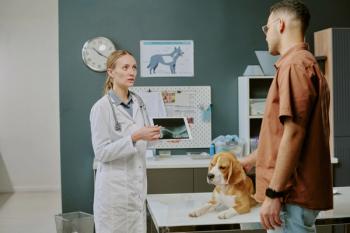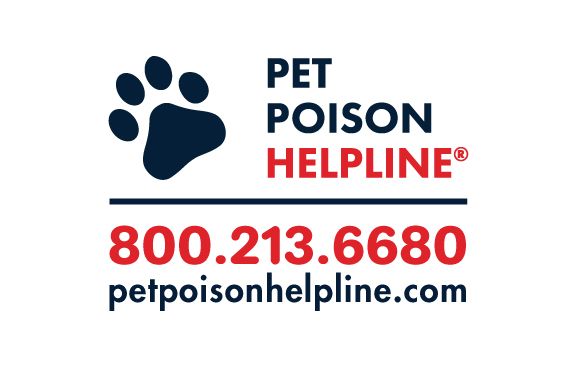
Toxin assessment basics: Steps for a successful approach to potential toxin exposures in the small animal patient

How to ask the right questions that lead to an appropriate and effective treatment plan
Content submitted by Pet Poison Helpline, a dvm360® Strategic Alliance Partner
Having a patient in your clinic who has been exposed to a potentially toxic substance can turn an already busy day into chaos as you try to determine their treatment needs. It is important to step back, remain calm, and make a full assessment of the patient and the toxicant before starting treatment. The following are ideal questions to ask when assessing every patient presenting to your clinic after a toxin exposure.
Is the patient stable?
Assessing the patient’s vitals and overall health status is often a key factor that is overlooked when presented with a panicked owner and patient. In many instances, specific information regarding the toxicant exposure may not be fully known at the time the patient presents for an evaluation. Looking at the overall health of the patient will help to avoid missteps, especially in patients that have numerous abnormalities or have been exposed to multiple toxins.
What is the signalment? (species, breed, age, weight)
Many patients respond differently to toxins depending on the species affected. Lilium sp. plants, for example, are a concern for acute kidney injury if ingested by feline patients, however, only mild gastrointestinal upset is expected in canines. Breed conformation and variation may affect the type of decontamination that is recommended or appropriate as well as toxin risks. Brachycephalic breeds, for example, may be at an increased risk for aspiration with emesis, making it important to weigh the risk vs benefit before inducing emesis in these patients. The ABCB1-1Δ gene mutation can affect up to 75% of dogs within certain breeds and up to 4% of all cats. These affected animals are at a higher risk of poisoning with certain medications including ivermectin or other macrocyclic lactones as well as certain opioids and chemotherapeutics including butorphanol, doxorubicin, vincristine, and vinblastine.1-3 Neonates and geriatric animals may have additional risk factors as some metabolic pathways are underdeveloped in the very young or have decreased activity in geriatric patients, potentially leading to more severe effects. An accurate weight, considering lean body mass, is critical in determining the ingested dose assessing the degree of toxicity for most ingestion exposures.
What is the current and past medical history including current medications?
Knowing the patient’s history and current health status will guide therapy decisions during treatment. Patients with a history of megaesophagus or laryngeal paralysis, as well as patients with current clinical signs of significant neurologic depression or are obtunded, are not ideal candidates for certain decontamination methods including emesis induction or activated charcoal administration. Certain medications may interact or worsen signs of poisoning depending on the exposure and should be known before therapy is initiated.
What was the toxin and route of exposure?
Identifying the specific toxin is crucial in most cases. For example, just knowing a patient ingested a “mouse bait rodenticide” does not mean treatment with Vitamin K1 is recommended. Bromethalin, cholecalciferol (Vitamin D3), and corn cellulose are also common active ingredients in rodenticides, each of which require very different therapeutic approaches. Many toxins have a different degree of toxicity or treatment needs based on the route of exposure. Was there dermal exposure to a liquid substance that was then licked and ingested by the animal or was it rolled in or walked through? Was a product designed for topical application given orally instead? Knowing the route of exposure allows one to make a more accurate assessment as to the toxicity risk and severity.
How much was the animal exposed to?
The “dose makes the poison” isn’t merely a quote passed down through the years. It is a valuable reminder that the dose the patient was exposed to dictates whether poisoning will occur and how severe the clinical signs will be. Not all exposures to potentially toxic substances will require treatment and assuming so may result in unnecessary management, added stress to the patient, and unwarranted cost to the client. For example, a 20-kg dog ingesting 1 peanut M&M represents a subtoxic dose, but that same dog ingesting a similar sized lead fishing sinker could result in fatality.
What is the time since exposure?
Knowing the time frame of a toxin exposure plays a large role in determining the type of decontamination that can or should be done. It also allows you to assess whether clinical signs are likely to develop. If an animal has been exposed to a toxin 4 hours prior that would undoubtedly cause clinical signs within a 1-2 hour timeframe, yet remains asymptomatic, there is a strong likelihood that a toxic exposure did not occur.
Where did the exposure occur?
Knowing the location of the exposure is helpful in determining other potential confounding factors as well as the potential severity of an exposure. For instance, an animal that is visiting a household may have more opportunities to be exposed to substances that are not typically present in their normal environment.
Putting it all together
Although treating patients exposed to a toxicant can be challenging, taking the time to ask the critical questions detailed in this article is the key to forming an accurate patient risk assessment and appropriate treatment plan. This information will enable you to determine if decontamination is advised for the patient, when to expect clinical signs to occur, what the prognosis is, and whether treatment is necessary in each scenario. Animal poison control centers such as Pet Poison Helpline are available 24 hours a day and staffed with toxicology experts and specialists to aide in determining the risk of potential poisonings. Veterinary toxicologists work in partnership with treating veterinarians to ensure they are equipped with the necessary information to maximize the likelihood of a successful outcome.
References
- Multidrug sensitivity in dogs and cats. Washington State University Veterinary Clincical Pharmacology Laboratory. Accessed March 18, 2022. https://vcpl.vetmed.wsu.edu/
- Mealy, KL. Ivermectin: Macrolide Antiparasitic Agents. In: Peterson ME, Talcott PA, eds. Small Animal Toxicology Third edition. Elsevier Health Sciences; 2013:601-607.
- Mealey KL, Burke NS. Identification of a nonsense mutation in feline ABCB1. J Vet Pharmacol Ther. 2015;38(5):429-433. doi:10.1111/jvp.12212
Newsletter
From exam room tips to practice management insights, get trusted veterinary news delivered straight to your inbox—subscribe to dvm360.





